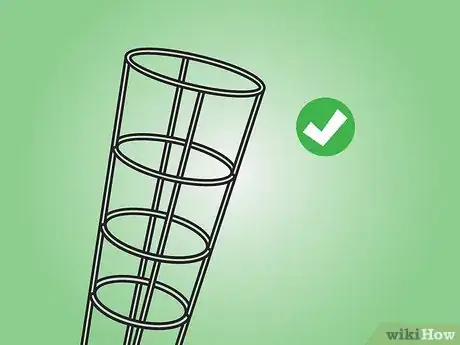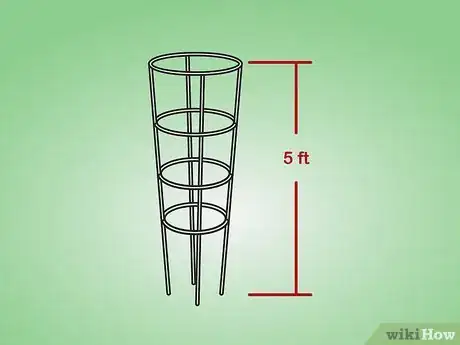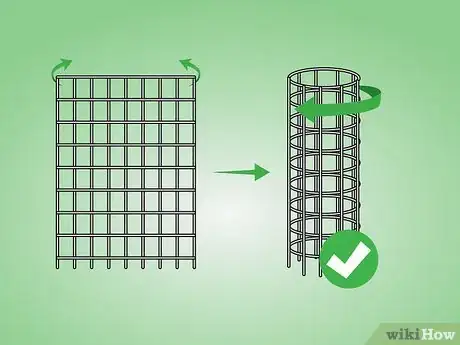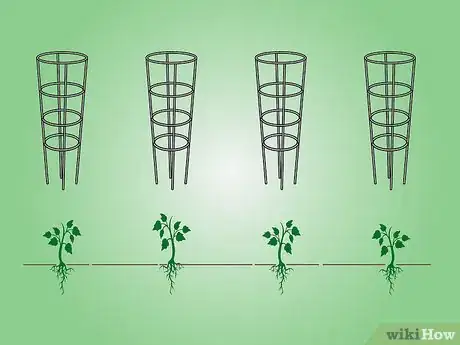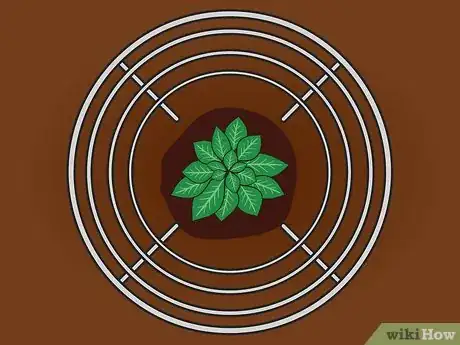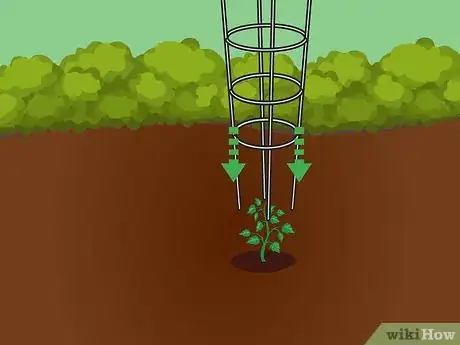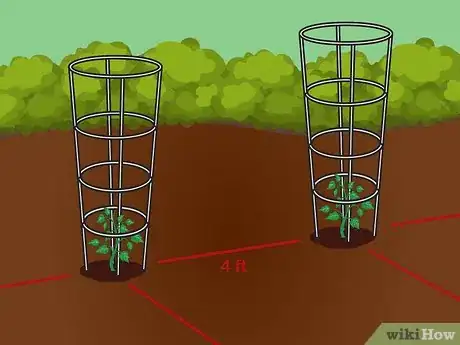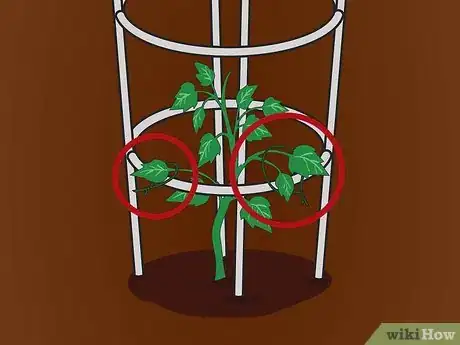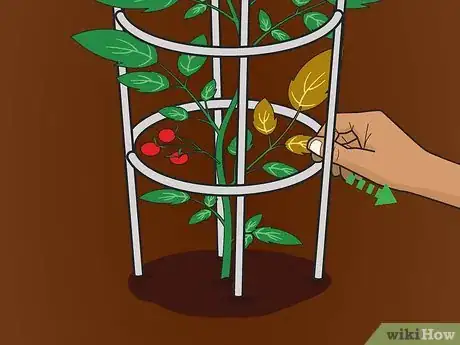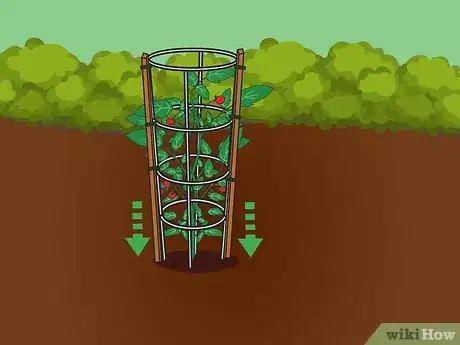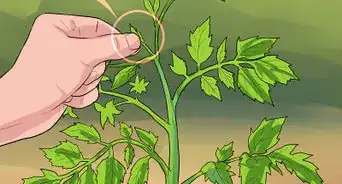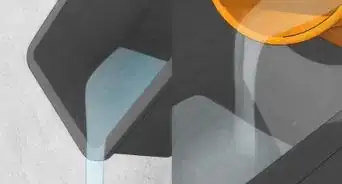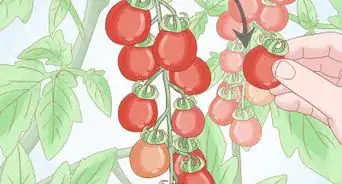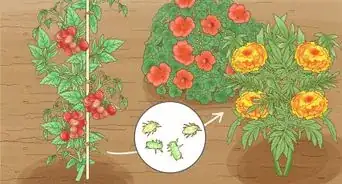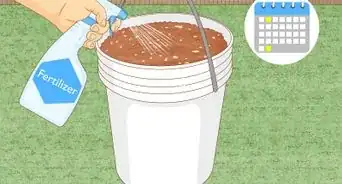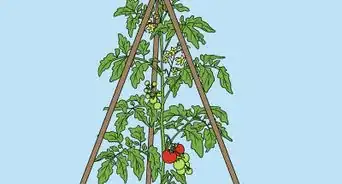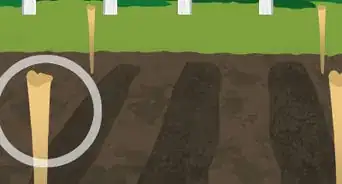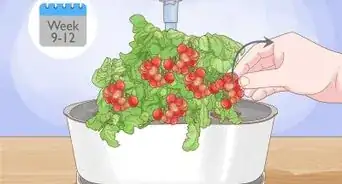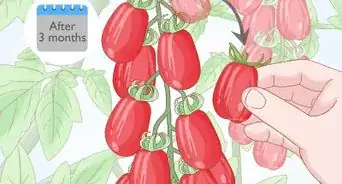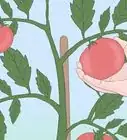This article was co-authored by Lauren Kurtz and by wikiHow staff writer, Kyle Hall. Lauren Kurtz is a Naturalist and Horticultural Specialist. Lauren has worked for Aurora, Colorado managing the Water-Wise Garden at Aurora Municipal Center for the Water Conservation Department. She earned a BA in Environmental and Sustainability Studies from Western Michigan University in 2014.
There are 8 references cited in this article, which can be found at the bottom of the page.
This article has been viewed 165,753 times.
Caging tomatoes is an effective way to grow the fruit and enjoy a delicious harvest. You can easily cage your own tomatoes by buying or making sturdy cages and properly installing them over your plants. Once the cages are in place, you’ll just need to occasionally tend to the plants and wait for them to produce tomatoes ripe enough for picking.
Steps
Choosing Tomato Cages
-
1Use metal tomato cages if you don't have a lot of space in your garden. Metal cages are thin and flexible, so you can squeeze them into a smaller space. This is especially helpful if your tomato plants are planted close together.
-
2Get tomato cages that are at least 5 feet (1.5 meters) tall. 5-foot cages will support most tomato varieties. If you're growing a shorter tomato variety, like Santiam or Siberia, you can choose a shorter cage.[1]Advertisement
-
3Choose a cage between 12-30 inches (30.5-76 cm) in diameter. Get a cage with a larger diameter if you're growing a large variety of tomato.[2]
-
4Make your own tomato cages using concrete reinforcement wire. You can find some at your local hardware store. Make sure you can fit your hand through the openings in the wire so you're able to harvest the tomatoes. Cut 3 feet (.9 meters) of wire for every 1 foot (.3 meters) in diameter you want each cage to be. Attach each end of the wire to a stake and stake the cage in the ground around one of your tomato plants.
-
5Get one cage for each tomato plant in the garden. Each tomato plant should have its own cage to grow in.
Setting up the Cages
-
1Place a cage directly over one of the tomato plants. Whether the plant is potted or in the ground, you want it to be in the center of the cage. The walls of the cage should be close to the plant; it's normal if some of the plant's vines and leaves extend outside of the cage.[3]
- Avoid damaging the plants' roots by caging them immediately after transplanting them.
-
2Push down on the cage so the stakes at the bottom go into the ground. Keep pushing down until all of the stakes are fully buried in the soil. If you’re having trouble getting the cage to push down, try lightly pounding it down with a mallet or hammer.[4]
-
3Check to see if the cage is sturdy. Put your hand on the cage and gently push and pull on it a little bit. If it feels like the wind could pull it out of the ground, attach a couple stakes to the bottom of the cage and pound them into the soil for extra support.[5]
- Attach the stakes to the outside of the cage so they don't damage the roots when you push them into the soil.
-
4Cage the rest of the tomato plants in the garden. Repeat the same process, making sure all of the cages are firmly staked in the ground. If you’re planting and caging new tomato plants, try to place them at least 4 feet (1.2 meters) apart.[6]
Caring for Caged Tomatoes
-
1Tie young, low-hanging vines on the plants to the tomato cages. This will encourage the tomato plants to grow upward in their cages. You can use something like floss or rubber bands to tie the vines to the cage. If you’re tying the vines, make sure they’re not too tight or you could injure the plant.[7]
-
2Trim off any dying leaves to conserve energy for the fruit. Pull the leaves off with your hands or use gardening shears. Trim the plants a couple times a week or whenever you notice wilting leaves.[8]
-
3Lift up a tomato cage if it falls and tie it to stakes to support the plant. Pound three or four stakes into the ground around the base of the fallen plant, taking care not to hammer the stakes into the plants roots. Loop garden twine or wire through the tomato cage and tie it to the stakes until the cage is supported.[9]
-
4Cut down the tomato plants in the fall once they die. You can tell the tomato plants are dead once they turn brown and yellow and begin to wilt. Use shears to cut any dead vines tangled around the cage. The tomato cages should remain on the plants until you are done harvesting.[10]
-
5Pull the cages out of the ground and store them until next year. Store the cages indoors where they won’t be damaged by the elements. Reuse the cages next year to grow more tomato plants.[11]
Community Q&A
-
QuestionHow can I keep white flies off of my tomato plants?
 NinoxTop AnswererThere are traps efficient against white flies. Another solution can be predatory insects like Encarsia Formosa and Macrolophus Caliginosus.
NinoxTop AnswererThere are traps efficient against white flies. Another solution can be predatory insects like Encarsia Formosa and Macrolophus Caliginosus. -
QuestionCan I put 6 tomato plants in 1 cage or should each plant have its own cage?
 ChrisTop AnswererYou should only put one plant per cage, as they will be overcrowded once mature. Tomato plants need room to spread and climb.
ChrisTop AnswererYou should only put one plant per cage, as they will be overcrowded once mature. Tomato plants need room to spread and climb.
References
- ↑ https://garden.org/learn/articles/view/363/
- ↑ https://garden.org/learn/articles/view/363/
- ↑ https://www.youtube.com/watch?v=9NfEf0jAaYo&feature=youtu.be&t=137
- ↑ https://www.youtube.com/watch?v=9NfEf0jAaYo&feature=youtu.be&t=137
- ↑ https://bonnieplants.com/library/how-to-support-tomatoes/
- ↑ https://bonnieplants.com/library/how-to-support-tomatoes/
- ↑ https://www.youtube.com/watch?v=n_YgI-6E9CU&feature=youtu.be&t=37
- ↑ https://www.youtube.com/watch?v=n_YgI-6E9CU&feature=youtu.be&t=68
- ↑ https://www.youtube.com/watch?v=rJTbARH3Zzg
About This Article
To cage tomatoes, start by picking a cage that is at least 5 feet tall and 12-30 inches in diameter. Next, place the cage directly over one tomato plant, pushing it down until the stakes are fully buried and the cage feels sturdy. If you have more than one tomato plant, go ahead and cage them all at the same time. After all of the cages are in place, tie young, low-hanging vines to the cages with floss or rubber bands. Then, once your tomatoes are caged, trim any dying leaves a few times a week so the plant has energy for the fruit. For more tips from our Horticultural reviewer, including how to remove the cages and store them for the next year, keep reading!
